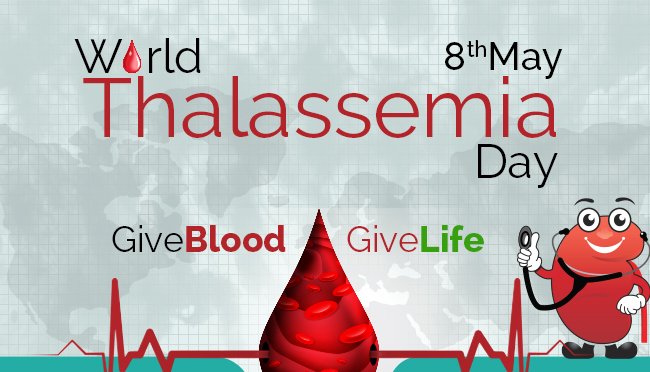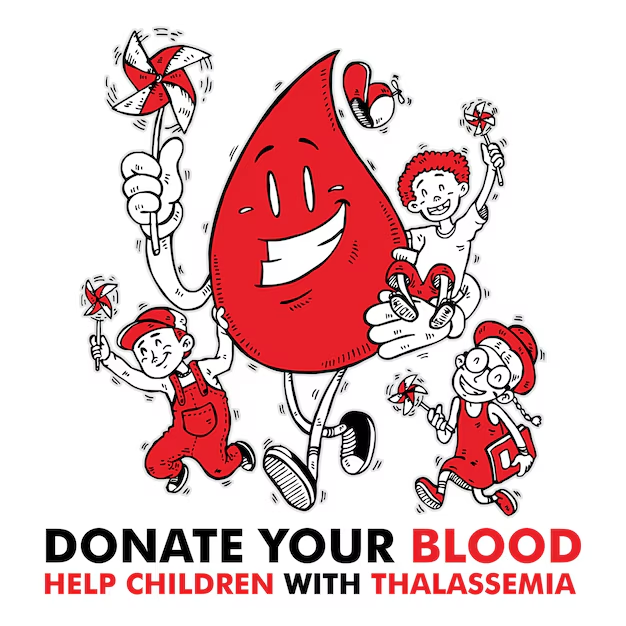World Thalassemia Day: Raising Awareness and Hope
Introduction

World Thalassemia Day is observed annually on May 8 to raise awareness about thalassemia, a genetic blood disorder that affects millions worldwide. The day serves as a reminder of the struggles faced by patients and their families while also emphasizing the importance of prevention, treatment, and research. It is an opportunity for healthcare organizations, governments, and communities to unite in efforts to educate people about the condition, promote early diagnosis, and encourage life-saving medical advancements.
Thalassemia is a chronic disorder that requires lifelong management, making awareness and support essential. Observing this day helps in advocating for better healthcare infrastructure, access to treatment, and ongoing research aimed at finding a cure. The event also fosters solidarity among patients, caregivers, and medical professionals, reinforcing the global commitment to improving the lives of those affected by thalassemia.
Understanding Thalassemia
Thalassemia is a genetic blood disorder that affects the body’s ability to produce hemoglobin, a crucial protein in red blood cells responsible for transporting oxygen to different tissues and organs. This leads to anemia, a condition where the body lacks enough healthy red blood cells to function effectively. Depending on the severity, thalassemia can range from mild to life-threatening.
The disorder is caused by mutations in the genes responsible for hemoglobin production, which are inherited from one or both parents. These genetic changes affect the production of alpha or beta globin chains, key components of hemoglobin. The severity of the disease depends on how many genes are affected and whether the mutation is inherited from one or both parents.
Thalassemia is most commonly found in people of Mediterranean, African, Middle Eastern, and South Asian descent due to its historical link with regions where malaria was prevalent. Carriers of thalassemia are thought to have had a survival advantage against severe malaria infections.
Types of Thalassemia
Thalassemia is broadly classified into two types based on the affected hemoglobin chains:
- Alpha Thalassemia – Occurs when there is a defect in the genes responsible for producing alpha-globin chains.
- Beta Thalassemia – Occurs when mutations affect the genes responsible for producing beta-globin chains.
Each type has different subcategories based on the severity of symptoms and the number of affected genes.
1. Alpha Thalassemia
The severity of alpha thalassemia depends on how many of the four alpha-globin genes are mutated or missing:
- Silent Carrier (1 Gene Mutated): No symptoms or very mild anemia.
- Alpha Thalassemia Trait (2 Genes Mutated): Mild anemia but usually no major health issues.
- Hemoglobin H Disease (3 Genes Mutated): Moderate to severe anemia, an enlarged spleen, and bone deformities.
- Alpha Thalassemia Major (4 Genes Mutated, Also Called Hydrops Fetalis): A life-threatening condition where a baby cannot produce enough hemoglobin, leading to stillbirth or death shortly after birth.
2. Beta Thalassemia
Beta thalassemia occurs when one or both beta-globin genes are defective. It has three main forms:
(a) Thalassemia Minor (Beta Thalassemia Trait)
- Individuals inherit one mutated gene from a parent.
- They may have mild anemia, which often goes unnoticed.
- People with thalassemia minor do not require treatment but can pass the gene to their children.
(b) Thalassemia Intermedia
- Occurs when both beta-globin genes are mutated, but they still produce some hemoglobin.
- Symptoms are moderate and may include fatigue, pale skin, bone abnormalities, and delayed growth.
- Individuals with thalassemia intermedia may require occasional blood transfusions, depending on symptom severity.
- Iron overload can be a concern, especially if frequent transfusions are needed.
(c) Thalassemia Major (Cooley’s Anemia)
- This is the most severe form of beta thalassemia.
- Occurs when both beta-globin genes are completely defective, preventing hemoglobin production.
- Symptoms typically appear within the first two years of life and include:
- Severe anemia, leading to weakness and fatigue.
- Growth delays and developmental problems in children.
- Bone deformities, especially in the face and skull.
- Enlarged spleen and liver, which can cause discomfort and increased risk of infections.
- Heart problems, such as heart failure, if left untreated.
- Patients with thalassemia major require lifelong blood transfusions to survive, typically every 2-4 weeks.
- Frequent transfusions lead to iron overload, which requires iron chelation therapy to prevent organ damage.
Diagnosis and Genetic Testing
Thalassemia is diagnosed using various blood tests, including:
- Complete Blood Count (CBC): Detects low hemoglobin and small, pale red blood cells.
- Hemoglobin Electrophoresis: Identifies abnormal hemoglobin types, such as fetal hemoglobin (HbF) or hemoglobin H.
- DNA Analysis: Confirms genetic mutations and helps identify carriers before having children.
Prenatal Testing (amniocentesis or chorionic villus sampling) is available for expecting parents at risk of having a child with severe thalassemia.
History and Significance
World Thalassemia Day was established by the Thalassemia International Federation (TIF) in memory of George Englezos, the son of TIF founder Panos Englezos, who lost his life to the disease. Since its inception, the day has aimed to spread awareness, encourage medical research, and improve the lives of those living with thalassemia.
The observance highlights the importance of early diagnosis, prevention strategies, and better treatment options for thalassemia patients worldwide. Each year, World Thalassemia Day is marked with a specific theme, focusing on critical issues such as improving access to treatment, advocating for patient rights, and supporting scientific advancements.
Over the years, governments, medical institutions, and non-governmental organizations have actively participated in awareness campaigns, blood donation drives, and educational programs. The day also serves as a platform for researchers and healthcare professionals to discuss new developments in gene therapy, bone marrow transplants, and emerging treatments that could offer a long-term cure for the disorder.
World Thalassemia Day is not only a time to educate the public but also an opportunity to honor patients, caregivers, and medical professionals who work tirelessly to manage and treat the condition. It reinforces the need for a global commitment to eradicating thalassemia through better healthcare policies, genetic screening programs, and enhanced medical research.
Screening Programs and Enhanced Medical Research
Screening programs play a vital role in early detection and prevention of thalassemia. These programs include:
- Neonatal Screening: Early screening of newborns helps in diagnosing thalassemia at birth, allowing for timely intervention.
- Carrier Screening: Genetic testing helps identify individuals who carry the thalassemia trait, providing them with counseling options before planning a family.
- Prenatal Testing: Expectant parents can undergo chorionic villus sampling (CVS) or amniocentesis to determine if their unborn child has thalassemia.
- Mass Awareness and Screening Campaigns: Governments and health organizations conduct awareness drives to encourage voluntary screening and educate people about genetic risks.
Enhanced medical research is crucial in developing more effective treatments and potential cures for thalassemia. Researchers are focusing on:
- Gene Therapy: A promising area of research aimed at correcting the defective gene responsible for thalassemia.
- Bone Marrow Transplantation: Advancements in stem cell therapy offer a potential cure for some patients.
- New Drug Development: Medications that enhance fetal hemoglobin production and reduce transfusion dependence are under trial.
- Improved Blood Transfusion Techniques: Efforts are being made to minimize complications associated with frequent transfusions and iron overload.

Symptoms and Diagnosis
Thalassemia symptoms can vary in severity and often depend on the type of the condition. Common symptoms include:
- Fatigue and Weakness: Due to insufficient oxygen supply in the blood.
- Pale or Yellowish Skin: A sign of anemia.
- Delayed Growth and Development: Especially in children with severe thalassemia.
- Bone Deformities: Particularly in the face and skull, due to bone marrow expansion.
- Enlarged Spleen and Liver: Caused by excessive red blood cell destruction.
- Shortness of Breath and Rapid Heartbeat: Resulting from oxygen deficiency.
Diagnostic Tests
To confirm thalassemia, doctors use various diagnostic tests, including:
- Complete Blood Count (CBC): Measures red blood cells and hemoglobin levels.
- Hemoglobin Electrophoresis: Identifies abnormal hemoglobin types.
- Genetic Testing: Detects specific gene mutations responsible for thalassemia.
- Iron Studies: Helps distinguish thalassemia from iron-deficiency anemia.
- Prenatal Testing: Conducted in high-risk pregnancies to detect thalassemia in the fetus.
Early detection through these diagnostic methods allows for better disease management and prevention of complications.
Treatment and Management of Thalassemia
Thalassemia treatment primarily focuses on alleviating symptoms, preventing complications, and improving the overall quality of life for affected individuals. The approach varies based on the severity of the condition, ranging from mild cases that require minimal intervention to severe cases that necessitate lifelong medical care.
1. Regular Blood Transfusions
For individuals with moderate to severe thalassemia, frequent blood transfusions are crucial to maintaining adequate hemoglobin levels and preventing severe anemia. These transfusions:
- Help improve oxygen transport in the body, reducing fatigue and weakness.
- Prevent growth delays and developmental issues in children.
- Reduce complications such as bone deformities and heart failure.
However, frequent transfusions can lead to iron overload, which requires additional management strategies.
2. Iron Chelation Therapy
Due to regular blood transfusions, excess iron accumulates in the body, which can damage vital organs such as the heart, liver, and endocrine glands. To prevent iron overload, iron chelation therapy is used to remove excess iron through medications such as:
- Deferoxamine (Desferal): Administered via injection or infusion.
- Deferasirox (Exjade, Jadenu) & Deferiprone (Ferriprox): Oral medications that help bind and remove excess iron from the body.
Proper iron chelation is essential to preventing complications like heart disease, diabetes, and liver dysfunction.
3. Bone Marrow or Stem Cell Transplant
A bone marrow or stem cell transplant is the only potential curative treatment for thalassemia. This procedure involves:
- Replacing the defective bone marrow with healthy stem cells from a matched donor, usually a sibling.
- Enabling the body to produce healthy red blood cells naturally, eliminating the need for transfusions.
However, this treatment has risks, including graft-versus-host disease (GVHD), infections, and complications from high-dose chemotherapy required before transplantation. It is generally considered for younger patients with severe thalassemia who have a compatible donor.
4. Medications and Emerging Treatments
Certain medications help manage symptoms and improve red blood cell production. These include:
- Hydroxyurea: Stimulates the production of fetal hemoglobin (HbF), which can improve oxygen transport and reduce the need for transfusions in some cases.
- Gene Therapy (Experimental): Research is ongoing into genetic treatments that can modify or replace the faulty gene responsible for thalassemia. Some trials have shown promising results in reducing the severity of the disease.
5. Lifestyle and Dietary Modifications
While medical treatments play a significant role, lifestyle choices also impact disease management. Recommended approaches include:
- Balanced Diet: Eating iron-controlled foods (avoiding excess red meat and iron-fortified cereals) and increasing folic acid, calcium, and vitamin D intake for bone health.
- Regular Exercise: Helps improve energy levels, maintain heart health, and strengthen muscles.
- Avoiding Iron Supplements and Certain Medications: Since thalassemia patients are prone to iron overload, supplements containing iron should be avoided unless prescribed by a doctor.
- Preventing Infections: Vaccinations (e.g., hepatitis B, pneumococcal, and meningococcal vaccines) are recommended to reduce the risk of infections due to frequent medical procedures.
6. Ongoing Monitoring and Preventive Care
Thalassemia is a lifelong condition that requires continuous medical supervision to detect and manage complications early. This includes:
- Regular Blood Tests: Monitoring hemoglobin levels, iron status, and organ function.
- Heart and Liver Assessments: Screening for iron overload-related damage using MRI scans and echocardiograms.
- Bone Density Tests: Checking for osteoporosis, a common issue in thalassemia patients.
Comprehensive medical care and patient education play a critical role in improving life expectancy and quality of life for those living with thalassemia.
Global Efforts and Awareness Campaigns
Organizations worldwide work tirelessly to spread awareness, fund research, and support patients. Governments and NGOs conduct screening programs, genetic counseling, and blood donation drives to manage the disease better.
The Thalassemia International Federation (TIF) plays a crucial role in advocating for patient rights, promoting global cooperation, and enhancing research efforts. Numerous national and regional organizations collaborate with TIF to conduct awareness campaigns, educate communities, and lobby for better healthcare policies.
Various global initiatives include:
- World Thalassemia Day Events: Conferences, seminars, and community outreach programs to educate people on prevention and management.
- Blood Donation Drives: Since thalassemia patients require frequent transfusions, numerous blood donation events are held globally.
- Advocacy for Government Policies: Many organizations push for the implementation of national thalassemia control programs, ensuring better healthcare access for patients.
- Research Grants and Funding: Governments and private institutions fund research to develop advanced treatments like gene therapy and new medications.
- Social Media Awareness Campaigns: Online campaigns using hashtags and stories help educate a larger audience about the challenges faced by thalassemia patients and ways to help.
Through these global efforts, the aim is to reduce the prevalence of thalassemia, improve patient care, and eventually find a permanent cure for the disorder
How You Can Help
There are several ways individuals can contribute to the fight against thalassemia:
- Donate Blood: Regular blood donations help meet the needs of thalassemia patients who require frequent transfusions.
- Raise Awareness: Share information on social media, participate in awareness events, and educate others about thalassemia.
- Support Research Organizations: Contribute to or volunteer with organizations funding research for better treatments and potential cures.
- Encourage Genetic Screening: Promote carrier screening and genetic counseling, especially in high-risk regions.
- Advocate for Policy Changes: Support policies that improve healthcare access for thalassemia patients and push for national screening programs.
World Thalassemia Day Quotes
“Let us not forget how much of a struggle it is for people suffering from thalassemia. Let us support them and make this life easier for them.”
“There are so many people out there suffering from thalassemia and they need our help. Let us step out and donate blood. Happy World Thalassemia Day to all.”
“Don’t miss a chance to be a hero to those who are in need of blood. Let us make it a meaningful and inspiring World Thalassemia Day for all.”
“There is no exercise better for the heart than reaching down and lifting people up.” Happy World Thalassemia Day.”
“There are so many people out there suffering from thalassemia and they need our help. Let us step out and donate blood.” Happy World Thalassemia Day.”
“Let us not forget how much of a struggle it is for people suffering from thalassemia. Let us support them and make this life easier for them.”
“You are lucky if you can donate your blood and become the reason for someone’s happiness.”
“Donating blood is a good habit as it brings smiles to many faces. Happy World Thalassemia Day.”
“Bleeding red is a way to help patients suffering from thalassemia. Happy World Thalassemia Day.”
“We must always come forward to donate blood and save lives.” Happy World Thalassemia Day.”
“Raising awareness today for a healthier tomorrow—together, we can fight thalassemia!”Happy World Thalassemia Day.”
“Knowledge is power! Educate, screen, and prevent thalassemia for future generations.” Happy World Thalassemia Day.”
“Hope, courage, and resilience—thalassemia warriors inspire us every day!” Happy World Thalassemia Day.”
“Every drop of blood counts. Donate blood, save a life!” Happy World Thalassemia Day.”
“A small act of kindness, like donating blood, can bring a lifetime of hope.” Happy World Thalassemia Day.”
“Your strength defines you, not your condition. Keep fighting, keep shining!” Happy World Thalassemia Day.”
“Thalassemia may be a part of your life, but it does not define who you are!” Happy World Thalassemia Day.”
“Science, support, and awareness—together, we can make life better for thalassemia patients.” Happy World Thalassemia Day.”
“Never lose hope. Medical advancements are creating a brighter future for thalassemia warriors!” Happy World Thalassemia Day.”
“Love, care, and medical breakthroughs—key ingredients in the fight against thalassemia.” Happy World Thalassemia Day.”
“Screen early, act wisely—thalassemia prevention starts with awareness!” Happy World Thalassemia Day.”
“Thalassemia is preventable. Spread awareness, get tested, and protect future generations.” Happy World Thalassemia Day.”
“Give the gift of life—become a blood donor today!” Happy World Thalassemia Day.”
“Together, we can turn awareness into action and action into a cure.” Happy World Thalassemia Day.”
“Thalassemia care starts with awareness. Let’s educate and advocate!” Happy World Thalassemia Day.”
Conclusion
World Thalassemia Day serves as a crucial platform to spread awareness and drive action towards better prevention, treatment, and research efforts. By fostering education, encouraging blood donations, and advocating for policy changes, we can work towards improving the quality of life for those affected. With ongoing medical advancements and global cooperation, there is hope for a future where thalassemia can be effectively managed, and ultimately, eradicated.
FOR MORE INFO
Want to read more articles like this? Explore now!









Recent Comments